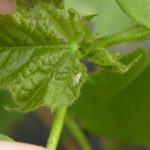
Cotton fields range from seedling to 9-10 nodes, or pinhead square. With the beginning of the fruiting process we enter into the damage window of the cotton fleahopper.
Fleahoppers can cause economic losses by feeding on small squares, or flower buds, causing the fruit to abscise and fall off of the plant. The resulting square loss can delay crop maturity and reduce yields.
Treatment should be considered when cotton fleahoppers are present in numbers above 15 per 100 plants.
Text below from “Cotton Fleahoppers”
The adult fleahopper is about 1/8-inch long, pale green, and has sucking mouthparts. It is flat, with an elongated, oval outline and prominent antennae. The body is usually yellowish-green, although it may be white or yellow with minute black spots and hairs on the upper surface.
Nymphs resemble adults but lack wings and are initially almost white or pink. After feeding, the immature stage is pale green with prominent, often reddish eyes (Fig. 2). Other parts of the body may also be reddish.
Nymphs are sometimes confused with immature minute pirate bugs, big-eyed bugs, aphids, and lygus bugs. But differences in color, shape, and behavioral patterns can help distinguish these insects from cotton fleahoppers.
Life Cycle. The cotton fleahopper overwinters in the egg stage, primarily in wild host plants such as woolly croton, horsemint, cutleaf evening primrose, showy sundrops, woolly tidestromia, spotted beebalm (horsemint), lemon beebalm (horsemint), and silverleaf nightshade. The eggs, rarely visible with typical scouting techniques, are about 1/30 of an inch long and inserted under the bark of small stems. At 80°F, eggs hatch in about 11 days, and the young nymphs feed on tender vegetation. They usually molt five times and in 14 to 15 days, mature into reproductive adult cotton fleahoppers.
Cotton fleahoppers can produce six to eight generations a year. Of these, only one to three occur in the cotton field. Early in the spring, fleahoppers build up large numbers on alternate hosts. As these hosts mature and become less succulent, or are controlled through weed management in the fields or along field margins, the cotton fleahopper searches for alternate hosts. If cotton is present, fleahoppers readily colonize it and feed on leaf and fruit buds, often found in large numbers well into boll development and beyond cutout (growth stage when no new squares will form).
Scouting. As the first small squares appear (approximately 4- to 6-leaf stage), examine the main stem terminal buds (about 3 to 4 inches of the plant top) of 25 plants at each of at least four locations across the field. Sample more sites in fields larger than 80 acres. Scout fields for cotton fleahoppers weekly. If conditions are conducive to the rapid buildup of cotton fleahoppers in alternate hosts, monitor fields every 3 to 4 days.
Cotton fleahoppers can be extremely “flighty,” flying or hiding within the plant canopy when disturbed. When approaching a plant to sample, watch for adults flying from it. Grasp the plant at about the middle of the main stem to help prevent nymphs from moving from the terminal toward the lower canopy before you have time to inspect the terminal. Count the number of adult and immature cotton fleahoppers.
Here is a short video on visual scouting for cotton fleahoppers:
More info at:



